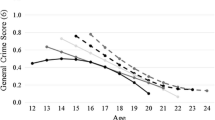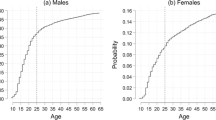Abstract
One of the most widely accepted findings in criminology is the strong curvilinear association between age and crime. Studies have indicated that involvement in criminal behavior rises throughout the teenage years until it levels off during the late teenage and early adult years and then declines throughout the remainder of the life span. Many of these studies, however, have relied on cross-sectional or repeated cross-sectional officially recorded data. In recent years, researchers investigating changes in self-reported criminal behavior among the same individuals as they age have discovered that involvement in criminal behavior actually declines during the adolescent years. Although there are a number of possible explanations for this phenomenon, we explore the extent to which this decline can be attributed to selective or non-random panel attrition.
Similar content being viewed by others
REFERENCES
Blumstein, A., Cohen, J., Roth, J., and Visher, C. (1986). Criminal Careers and “Career Criminals”, National Academy Press, Washington, DC.
Blumstein, A., Cohen, J., and Farrington, D. P. (1988). Criminal career research: Its value for criminology. Criminology 26: 1–35.
Cernkovich, S. A., Giordano, P. C., and Pugh, M. D. (1985). Chronic offenders: The missing cases in self-report delinquency research. J. Crim. Law Criminol. 76: 705–732.
Cernkovich, S. A., and Giordano, P. C. (2001). Stability and change in antisocial behavior: The transition from adolescence to early adulthood. Criminology 39: 371–410.
Cordray, S., and Polk, K. (1983). The implications of respondent loss in panel studies of deviant behavior. J. Res. Crime Delinq. 20: 214–242.
Elliott, D. S., Huizinga, D., and Menard, S. (1989). Multiple Problem Youth. Springer-Verlag, New York.
Farrington, D. P. (1986). Age and crime. In Tonry, M. and Morris, N. (eds.), Crime and Justice: An Annual Review of Research, Volume 7. University of Chicago Press, Chicago, IL, pp. 189–250.
Fay, R. E. (1989). Estimating nonignorable nonresponse in longitudinal surveys through causal modeling. In Kasprzyk, D., Duncan, G. J., Kalton, G., and Singh, M. P. (eds.), Panel Surveys. Wiley Interscience, New York, pp. 375–399.
Gottfredson, M. R., and Hirschi, T. (1990). A General Theory of Crime, Stanford University Press, Stanford, CA.
Greenberg, D. F. (1991). Modeling criminal careers. Criminology 29: 17–46.
Greene, W. H. (1997). Econometric Analysis (third edition), Prentice-Hall, Upper Saddle River, NJ.
Hirschi, T., and Gottfredson, M. R. (1983). Age and the explanation of crime. Am. J. Sociol. 89: 552–584.
Jang, S. J. (1999). Different definitions, different modeling decisions, and different interpretations: A rejoinder to Lauritsen. Criminology 37: 695–702.
Kessler, R. C., and Greenberg, D. F. (1981). Linear Panel Analysis: Models of Quantitative Change, Academic Press, New York.
Krohn, M. D., and Thornberry, T. P. (1999). Retention of minority populations in panel studies of drug use. Drugs and Society 14: 185–207.
Lauritsen, J. L. (1998). The age-crime debate: assessing the limits of longitudinal self-report data. Social Forces 77: 127–155.
Lauritsen, J. L. (1999). Limitations in the use of longitudinal self-report data: A comment. Criminology 37: 687–694.
Le Blanc, M., and Loeber, R. (1998). Developmental criminology updated. In Tonry, M. (ed.), Crime and Justice: A Review of Research, Volume 23. University of Chicago Press, Chicago, IL, pp. 115–198.
Lepkowski, J. M. (1989). Treatment of wave nonresponse in panel surveys. In Kasprzyk, D., Duncan, G. J., Kalton, G., and Singh, M. P. (eds.), Panel Surveys, Wiley Interscience, New York, pp. 348–374.
Little, R. J. A. (1995). Modeling the drop-out mechanism in repeated-measures studies. J. Am. Stat. Assoc. 90: 1112–1121.
Little, R. J. A., and Rubin, D. B. (1987). Statistical Analysis with Missing Data, Wiley, New York.
Little, R. J. A., and Su, H. (1989). Item nonresponse in panel surveys. In Kasprzyk, D., Duncan, G. J., Kalton, G., and Singh, M. P. (eds.), Panel Surveys, Wiley Interscience, New York, pp. 400–425.
Loeber, R., and Le Blanc, M. (1990). Toward a developmental criminology. In Tonry, M. and Morris, N. (eds.), Crime and Justice: A Review of Research, Vol. 12. University of Chicago Press, Chicago, IL, pp. 375–473.
Loeber, R., Wei, E., Stouthamer-Loeber, M., Huizinga, D., and Thornberry, T. P. (1999). Behavioral antecedents to serious and violent offending: Joint analyses from the Denver Youth Survey, Pittsburgh Youth Study and the Rochester Youth Development Study. Studies on Crime and Crime Prevention 8: 245–264.
Manski, C. F. (1995). Identification Problems in the Social Sciences, Cambridge University Press, New York.
Manski, C. F., and Nagin, D. S. (1998). Bounding disagreements about treatment effects: a case study of sentencing and recidivism. Sociol. Methodol. 28: 99–137.
Marini, M. M., Olsen, A. R., and Rubin, D. B. (1979). Maximum-likelihood estimation in panel studies with missing data. Sociol. Methodol. 11: 314–357.
Moffitt, T. E. (1993). Adolescence-limited and life-course persistent antisocial behavior: a developmental taxonomy. Psychol. Rev. 100: 674–701.
Nagin, D. S. (1999). Analyzing developmental trajectories: A semiparametric, group-based approach. Psychol. Meth. 4: 139–157.
Nagin, D. S., and Farrington, D. P. (1992). The stability of criminal potential from childhood to adulthood. Criminology 30: 111–139.
Nagin, D. S., and Paternoster, R. (1991). On the relationship of past to future delinquency. Criminology 29: 163–189.
Piquero, A. R., MacIntosh, R., and Hickman, M. (2002). The validity of a self-reported delinquency scale. Sociol. Method. Res. 30: 492–529.
Saphire, D. G. (1984). Estimation of Victimization Prevalence Using Data from the National Crime Survey, Lecture Notes in Statistics, 23. Springer-Verlag, New York.
Smith, D. A., Wish, E. D., and Jarjoura, G. R. (1989). Drug use and pretrial misconduct in New York City. J. Quant. Criminol. 5: 101–126.
Stasny, E. A. (1991). Hierarchical models for the probabilities of a survey classification and nonresponse: an example from the National Crime Survey. J. Am. Stat. Assoc. 86: 296–303.
Steffensmeier, D., Allan, E., Harer, M., and Streifel, C. (1989). Age and the distribution of crime. Am. J. Sociol. 94: 803–831.
Thornberry, T. P. (1989). Panel effects and the use of self-reported measures of delinquency in longitudinal studies. In Klein, M. W. (ed.), Cross-National Research in Self-Reported Crime and Delinquency, Kluwer Academic Publishers, Los Angeles, pp. 347–369.
Thornberry, T. P., and Krohn, M. D. (2000). The self-report method for measuring delinquency and crime. In Duffee, D. (ed.), Measurement and Analysis of Crime and Justice: Criminal Justice 2000, National Institute of Justice, Washington, DC, pp. 33–83.
Thornberry, T. P., Bjerregaard, B., and Miles, W. (1993). The consequences of respondent attrition in panel studies: A simulation based on the Rochester Youth Development Study. J. Quant. Criminol. 9: 127–158.
Wainer, H. (1986). Drawing Inferences from Self-Selected Samples, Springer-Verlag, New York.
Woltman, H., and Bushery, J. (1984). Summary of results from the National Crime Survey panel bias study. In Lehnen, R. and Skogan, W. (eds.), The National Crime Survey Working Papers, Volume II: Methodological Studies, U.S. Government Printing Office, Washington, DC, pp. 98–100.
Author information
Authors and Affiliations
Rights and permissions
About this article
Cite this article
Brame, R., Piquero, A.R. Selective Attrition and the Age-Crime Relationship. Journal of Quantitative Criminology 19, 107–127 (2003). https://doi.org/10.1023/A:1023009919637
Issue Date:
DOI: https://doi.org/10.1023/A:1023009919637




